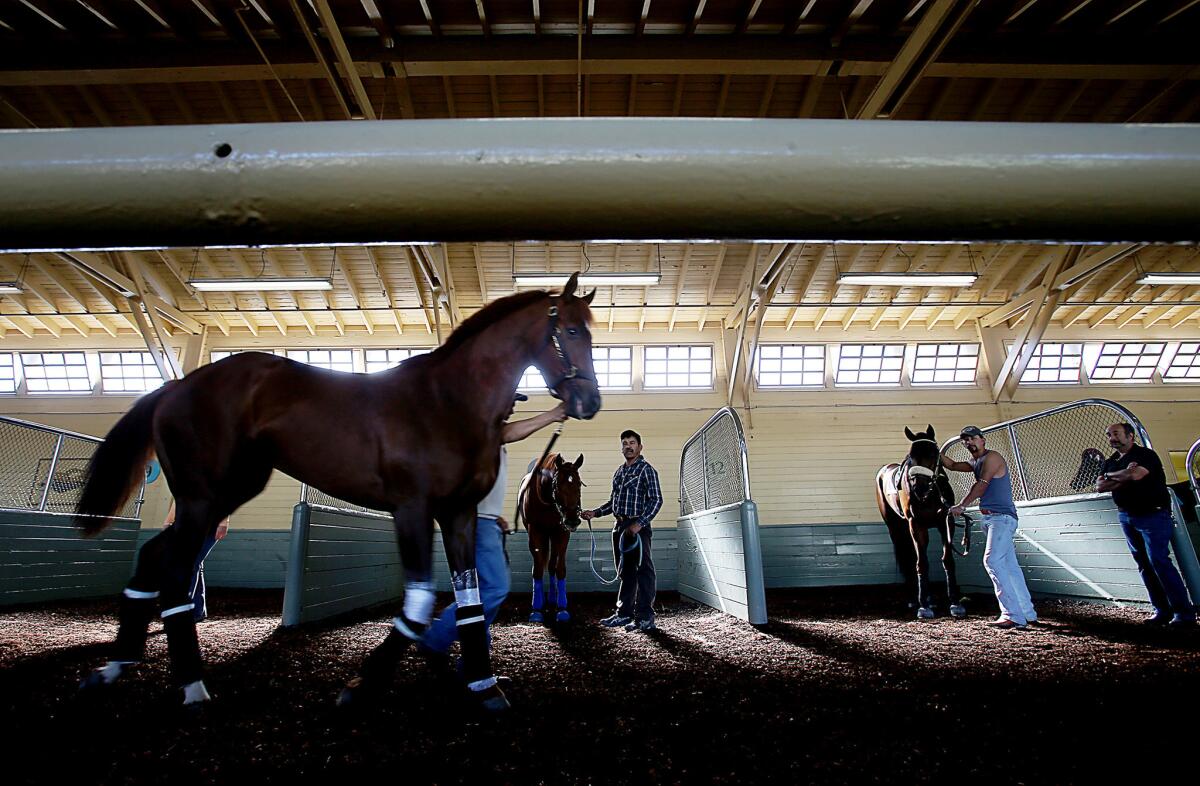Editorial: Horses are still dying at Santa Anita and something has to give

- Share via
After a tumultuous season in which dozens of horses died at the fabled Santa Anita Park, officials put in place a slew of groundbreaking reforms before the start of the 2019 fall meeting: tough new drug restrictions, the addition of four more veterinarians to oversee the horses, new rules on when horses could be trained and when they had to be stabled at the park before a race. Horses were already being blood- tested before races for evidence of “milkshaking”— in which a horse is given the performance enhancing drug sodium bicarbonate through a tube up the nose. Also, horses are randomly drug-tested after races.
Still, despite the tough new rules, there were six deaths in racing or training during the six-week fall meeting leading up to the prestigious and lucrative Breeders’ Cup races on Friday and Saturday. Then, in the last race of the Breeder’s Cup on Saturday, Mongolian Groom suffered a severe injury to his left hind leg and was euthanized. So the park has seen a total of 37 racing or training deaths during the 2019 season — matching the park’s record last year. It was the surge in deaths over a few weeks at the park earlier this year that raised an alarm at the track and a public outcry that put the park and the sport in general under an extraordinary scrutiny — and rightly so. That alarm led to the reforms now in place.
According to statistics compiled by the Jockey Club, of the roughly 49,000 thoroughbred horses that raced last year, 493 suffered racing fatalities. That doesn’t include training deaths. The average death per start — a start occurs each time a horse begins a race — in the U.S. last year was 1.68 deaths per 1,000 starts. Santa Anita last year was above average with 2.04 deaths per 1,000 starts. But other parks had worse records.
The idea is to institute reforms that bring down fatalities dramatically. Death should not be a regular or acceptable byproduct of horse racing.
Santa Anita appears to be working hard on this. In addition to the reforms above, new diagnostic tools — a standing MRI machine and a PET scanner — should be in place by the start of the next racing season at the end of December.
But even more can and should be done. Advocates from People for the Ethical Treatment of Animals have urged Santa Anita to put in a CT scanner that can take images of all four legs of a horse at once. Park veterinarians say they are working on finding the right one. The more varied diagnostic tools the park has, says Santa Anita’s chief veterinary officer, Dionne Benson, the better they can evaluate the condition of horses before they’re cleared to race.
The park should also put in a place a central pharmacy from which all drugs would be obtained. Benson supports this as a way to monitor all the drugs given to horses during the days or weeks that they are at Santa Anita. (The track would enforce this through its on-site investigators and the hundreds of cameras in place.) And the park should seriously consider replacing its dirt track with a synthetic track. The park did this once before and took it out. It can be difficult to maintain but there is evidence that there are fewer fatalities on it. And the park has to continue to police trainers. The park has already banished trainers whose horses have suffered disproportionate fatalities.
Meanwhile, Congress should pass the Horseracing Integrity Act, creating an independent horse-racing authority to set nationwide rules.
The troubling thing is that even experts such as Benson are stumped by what is causing the recent deaths at Santa Anita and elsewhere. It would help if Benson had the necropsies of all the horses. The L.A. County district attorney’s office set up a task force to investigate the deaths six months ago and the results are still not public nor does the office have a time frame for when they will be released.
Benson says her goal is “safe horse racing with zero fatalities,” but she acknowledges how difficult it will be to get to that.
Hopefully, even more changes at the park will get Santa Anita closer. If it can’t, and if no racing park in the United States can, then the inescapable question for elected officials and the public in California and across the nation is: Do we want to continue a sport — even a historic and beloved sport — in which horses’ lives are routinely sacrificed so that people can be entertained?
More to Read
A cure for the common opinion
Get thought-provoking perspectives with our weekly newsletter.
You may occasionally receive promotional content from the Los Angeles Times.










